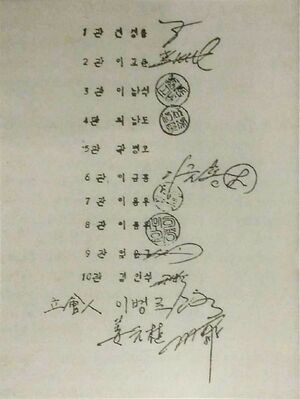
Signatures on the Unification Proclamation
The Unification Proclamation was an agreement signed by the Nine Kwans circa 1978 (some sources say 1977), uniting all the remaining martial arts schools in South Korea under a common style of taekwondo.
In 1959 the Korean Tae Kwon Do Association (KTA) was formed with the charter to formalize and promote the newly integrated Korean martial art, "taekwondo." There was some controversy however regarding what it meant to have a "unified" martial arts style. Would all of the kwans teach the same techniques and forms, or would they continue to promote their own individual variations? Perhaps more importantly, would each kwan continue to award its own black belts, or would they yield that authority to some central agency? These questions were not resolved until 1978 with the signing of the Unification Proclamation. The KTA was also chartered with kwan consolidation: between 1960 and 1971 the KTA was able to negotiate the consolidation of 40 kwans down to just 14 kwans.
In 1973 the KTA's efforts to develop a unified style was formalized under the banner of the Kukkiwon (the "national academy" for taekwondo). Within Korea, however, the individual kwan system persisted for another five years, until 1978. On August 7, 1978 the existing kwans at that time came together and signed a Unification Proclamation pledging their support for Kukkiwon, thereby finalizing the Kwan Unification that had first been triggered by Nam Te Hi's famous 1954 tile break:
- "Taekwondo will strive hard to unify and will eliminate the different Kwan of the last 30 years. Since 1972, we unified the Taekwondo terminology and poomsae in order to minimize the differences which existed between the different Kwan. With respect to Dan Promotion Tests, the Sabum in the individual dojang will recommend the candidates for rank advancement. We will do our duty to treat everyone as equals and to work towards a clean administrative procedural system. Because Taekwondo is our National Sport we promise to be good leaders and unify all Taekwondo-in throughout the nation. We will close all Kwan offices and the Chong Bon Kwan will instead coordinate with the Kukkiwon so that we can keep our administration clean. We promise to do our part to unify Taekwondo."
The proclamation was signed by
- Chun Jung Woong representing Song Moo Kwan
- Lee Kyo Yoon representing Han Moo Kwan
- Lee Nam Suk representing Chang Moo Kwan
- Choi Nam Do representing Moo Duk Kwan
- Kwak Byung Oh representing Oh Do Kwan (note that this line is unsigned)
- Lee Kum Hong representing Kang Duk Won
- Lee Yong Woo representing Jung Do Kwan
- Lee Chong Woo representing Ji Do Kwan
- Uhm Woon Kyu representing Chung Do Kwan
- Kim In Suk representing Kwan Ri Kwan
- Lee Byung Ro and Kang Won Sik representing Chong Bon Kwan
This unification was not without its critics however. Some felt that the adoption of a single, unified style -- with a single agency (the Kukkiwon) alone awarding black belts -- put an end to the diverse Korean martial arts traditions of the 1940s-1960s.
Despite this critique, the newly unified Kukkiwon-style taekwondo became very successful. With support from the Kukkiwon, the World Taekwondo Federation (WTF) was established in 1973 to promote Kukkiwon-style taekwondo as a competitive sport. One of the WTF's first great achievements was the introduction of taekwondo to the 1988 Seoul Olympics as a demonstration sport. In the year 2000 taekwondo made its appearance as a fully official Olympic sport at the summer Olympics in Sydney, Australia. Taekwondo was the first martial art to be added to the Olympics since judo was added in 1964.